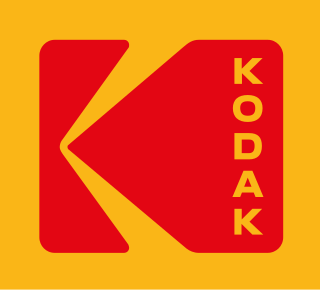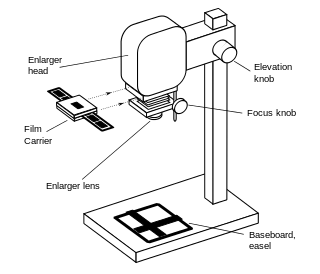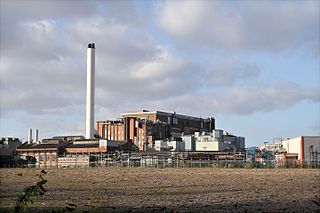
Film stock is an analog medium that is used for recording motion pictures or animation. It is recorded on by a movie camera, developed, edited, and projected onto a screen using a movie projector. It is a strip or sheet of transparent plastic film base coated on one side with a gelatin emulsion containing microscopically small light-sensitive silver halide crystals. The sizes and other characteristics of the crystals determine the sensitivity, contrast and resolution of the film. The emulsion will gradually darken if left exposed to light, but the process is too slow and incomplete to be of any practical use. Instead, a very short exposure to the image formed by a camera lens is used to produce only a very slight chemical change, proportional to the amount of light absorbed by each crystal. This creates an invisible latent image in the emulsion, which can be chemically developed into a visible photograph. In addition to visible light, all films are sensitive to X-rays and high-energy particles. Most are at least slightly sensitive to invisible ultraviolet (UV) light. Some special-purpose films are sensitive into the infrared (IR) region of the spectrum.

The Eastman Kodak Company is an American public company that produces various products related to its historic basis in analogue photography. The company is headquartered in Rochester, New York, and is incorporated in New Jersey. Kodak provides packaging, functional printing, graphic communications, and professional services for businesses around the world. Its main business segments are Print Systems, Enterprise Inkjet Systems, Micro 3D Printing and Packaging, Software and Solutions, and Consumer and Film. It is best known for photographic film products.

George Eastman was an American entrepreneur who founded the Eastman Kodak Company and helped to bring the photographic use of roll film into the mainstream. He was a major philanthropist, establishing the Eastman School of Music, Rochester Philharmonic Orchestra, and schools of dentistry and medicine at the University of Rochester and in London Eastman Dental Hospital; contributing to the Rochester Institute of Technology (RIT) and the construction of several buildings at the second campus of Massachusetts Institute of Technology (MIT) on the Charles River. In addition, he made major donations to Tuskegee University and Hampton University, historically black universities in the South. With interests in improving health, he provided funds for clinics in London and other European cities to serve low-income residents.

The Brownie was a series of cameras made by Eastman Kodak. Released in 1900, it introduced the snapshot to the masses. It was a basic cardboard box camera with a simple convex-concave lens that took 2 1/4-inch square pictures on No. 117 roll film. It was conceived and marketed for sales of Kodak roll films. Because of its simple controls and initial price of $1 along with the low price of Kodak roll film and processing, the Brownie camera surpassed its marketing goal.

Kodachrome is the brand name for a color reversal film introduced by Eastman Kodak in 1935. It was one of the first successful color materials and was used for both cinematography and still photography. For many years Kodachrome was widely used for professional color photography, especially for images intended for publication in print media.

Photographic plates preceded photographic film as a capture medium in photography, and were still used in some communities up until the late 20th century. The light-sensitive emulsion of silver salts was coated on a glass plate, typically thinner than common window glass.

An enlarger is a specialized transparency projector used to produce photographic prints from film or glass negatives, or from transparencies.

The history of the camera began even before the introduction of photography. Cameras evolved from the camera obscura through many generations of photographic technology – daguerreotypes, calotypes, dry plates, film – to the modern day with digital cameras and camera phones.

The George Eastman Museum, also referred to as George Eastman House, International Museum of Photography and Film, the world's oldest museum dedicated to photography and one of the world's oldest film archives, opened to the public in 1949 in Rochester, New York.

In still photography, Kodak's Kodacolor brand has been associated with various color negative films since 1942. Kodak claims that Kodacolor was "the world's first true color negative film". More accurately, it was the first color negative film intended for making paper prints: in 1939, Agfa had introduced a 35 mm Agfacolor negative film for use by the German motion picture industry, in which the negative was used only for making positive projection prints on 35 mm film. There have been several varieties of Kodacolor negative film, including Kodacolor-X, Kodacolor VR and Kodacolor Gold.
Eastman Business Park, formerly Kodak Park, is a large manufacturing and industrial complex in the city of Rochester, New York, in the United States. The complex is run by Eastman Kodak and is located 3 miles (5 km) north of downtown Rochester and 4 miles (6 km) south of Lake Ontario. The complex runs parallel to New York State Route 104 and Mount Read Boulevard for most of its length. Also part of the complex is the Kodak Center performing arts center and conference facility.

Kodak Hall atEastman Theatre is the largest performance venue at the Eastman School of Music of the University of Rochester, located in downtown Rochester, New York.

Kodak is an unincorporated community and a neighborhood of Sevierville in Sevier County, Tennessee, United States. It is located along State Highway 139 and State Highway 66, and just south of I-40 and Knoxville, Tennessee. The elevation of Kodak is about 896 feet above sea level.

Kodak Tower is a 19-story skyscraper in the High Falls District of Rochester, New York, and is part of the Eastman Kodak Headquarters complex. It has a roof height of 340 ft (103.6 m) and stands 366 ft (111.6 m) with its antenna spire included. It was Rochester, New York's tallest building for over 50 years from its completion in 1914 until the Xerox Square Tower surpassed it in the late 1960s. Today, it is the 4th tallest building in Rochester, NY and is the 9th tallest building in New York State outside NYC.

Loyd Ancile Jones was an American scientist who worked for Eastman Kodak Company, where he was head of its physics department for many years. During World War I, he was also a major contributor to the development of naval camouflage.

ESL Federal Credit Union is a full-service financial institution with headquarters in Rochester, New York. The locally owned financial institution employs more than 870 people in Rochester, New York and, includes more than 376,000 members and 11,800 businesses. The company has now appeared on the Great Place to Work Best Small and Medium Workplaces for 10 years. Access to the credit union includes 22 branch locations and more than 40 ATM locations, locally based telephone and internet chat centers, and online and mobile banking channels. Membership in ESL is open to employees of Eastman Kodak, members of the George Eastman House, and residents of Rochester, among others.

"You Press the Button, We Do the Rest" was an advertising slogan coined by George Eastman, the founder of Kodak, in 1888. Eastman believed in making photography available to the world, and making it possible for anyone who had the desire to take great pictures. Until then, taking photographs was a complicated process that could only be accomplished if the photographer could process and develop film. With his new slogan, Eastman and the Eastman Kodak Company became wildly successful and helped make photography popular.

The Kodak Starflash belongs to the Kodak Brownie Star- lineup of cameras made by the Eastman Kodak Company in the United States and France between 1957-1965 and sold for $8.50.

The Kodak Works, Harrow was a photographic manufacturing plant and research and development centre on Headstone Drive, Harrow, North West London. Built by the American Kodak company in 1890, it was their largest factory in the United Kingdom and at its peak in the mid-20th century employed up to 6,000 workers. Production of photographic film ended in 2005 and the plant closed its doors in 2016.

The Kodak Panoram camera was a roll-film swing-lens panoramic camera made in Rochester, New York, USA by Eastman Kodak between 1899 and 1928.






















